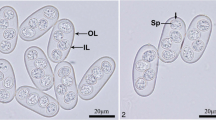Abstract
Coprological examination of 15 samples of the rough-tailed gecko Cyrtopodion scabrum collected from Abu Rawash, Giza, Egypt, revealed that 20 % (3/15) were passing oocysts of a new Choleoeimeria species. Oocysts of Choleoeimeria scabrumi n. sp. are ellipsoidal with a smooth, yellow to orange, bilayered smooth wall, measure 26 × 13 μm, and have a length/width (L/W) ratio of 1.8. Polar granule, micropyle and oocyst residuum are absent. Sporocysts are ellipsoidal and 8 × 5 μm and the sporocyst wall has two plates joined by a longitudinal suture. Stieda, substieda and parastieda bodies are absent. The endogenous development is confined to the gallbladder epithelium. Mature meronts are subspheroidal and 11–13 × 8–10 μm. Macrogamonts are mostly spheroidal and 12–14 μm wide, with a prominent nucleus in the centre. Microgamonts are irregular in shape, 9–11 × 5–7 μm. Based on the morphological features of the oocysts and the endogenous development in the gallbladder epithelium, we identified this biliary coccidium to be a new species in the genus Choleoeimeria.



Similar content being viewed by others
References
Abdel-Baki AS (2014) Description of Choleoeimeria duszynskii n. sp. (Apicomplexa: Eimeriidae) from the gall bladder of the Middle Eastern short-fingered gecko Stenodactylus doriae Blanford (Sauria: Gekkonidae) in Saudi Arabia. Syst Parasitol 87:299–304
Abdel-Baki AS, Al-Quraishy S, Duszynski DW (2014) Choleoeimeria salaselensis sp. n. (Apicomplexa: Eimeriidae) from the gall bladder of the horned viper Cerastes gasperettii (Serpentes: Viperidae) in Saudi Arabia. Folia Parasitol 61:201–205
Al-Quraishy S, Abdel-Baki AS, Al Otaibi MSA (2013) Choleoeimeria bunopusi sp. n. (Apicomplexa: Eimeriidae) infecting the gall bladder of the tuberculated gecko Bunopus tuberculatus (Reptilia: Gekkonidae) from Saudi Arabia. Acta Protozool 52:267–272
Asmundsson I (2003) Eimeriid parasites of Guatemalan reptiles and amphibians, and their phylogenetic relationship to other Eimeriid parasites. Ph. D. thesis, The University of New Mexico, Albuquerque, New Mexico, USA
Daszak P, Ball SJ, Jones CG, Streicker DG, Snow KR (2009) Six new species of coccidia (Apicomplexa: Eimeriidae) from endangered Phelsuma spp. geckoes (Sauria: Gekkonidae) of the Black River Gorges National Park, Mauritius. Folia Parasitol 56:233–241
Duszynski DW, Wilber PG (1997) Guidelines for publishing new species descriptions of eimerians (Apicomplexa: Eimeriidae). J Parasitol 83:333–336
Jirků M, Jirků M, Oborník M, Lukeš J, Modrý D (2009) A model for taxonomic work on homoxenous coccidia: redescription, host specificity, and molecular phylogeny of Eimeria ranae Dobell, 1909, with a review of anuran-host Eimeria (Apicomplexa: Eimeriorina). J Eukaryot Microbiol 56:39–51
Jirků M, Modrý D, Šlapeta JR, Koudela B, Lukeš J (2002) The phylogeny of Goussia and Choleoeimeria (Apicomplexa; Eimeriorina) and the evolution of excystation structures in coccidia. Protist 153:380–389
Lainson R, Paperna I (1999) Some coccidia from the gall bladder and intestine of the teiid lizard Ameiva ameiva ameiva and the gecko Hemidactylus mabouia in North Brazil. Parasite 6:151–162
McAllister CT, Upton SJ, Trauthf SE (1994) New host and distribution records for Coccidia (Apicomplexa: Eimeriidae) from North American lizards (Reptilia: Sauria). J Helminthol Soc Wash 61:221–224
Modrý D, Jirků M (2006) Three new species of coccidia (Apicomplexa: Eimeriorina) from the marble-throated skink, Marmorosphax tricolor Bavay, 1869 (Reptilia: Scincidae), endemic to New Caledonia with a taxonomic revision of Eimeria spp. from scincid hosts. Parasitol Res 99:419–428
Paperna I, Landsberg JH (1989) Description and taxonomic discussion of eimerian coccidian from African and Levantine geckoes. S Afr J Zool 24:345–355
Paperna I (2007) New species of Choleoeimeria (Apicomplexa: Eimeriidae), coccidian of bile-bladder of reptiles, illustrating a multiplicity of host cell-parasite interrelations. Parassitologia 49:81–95
Tenter AM, Barta JR, Beveridge I, Duszynski DW, Mehlhorn H, Morrison DA, Thompson RCA, Conrad PA (2002) The conceptual basis for a new classification of the coccidia. Int J Parasitol 32:595–616
Uetz P, Hošek J (eds.) (2013) The reptile database: http://www.reptile-database.org/. Accessed August, 2013
Yang R, Brice B, Bennett MD, Ryan U (2013) Novel Eimeria sp. isolated from a King’s skink (Egernia kingii) in Western Australia. Exp Parasitol 133:162–165
Author information
Authors and Affiliations
Corresponding author
Rights and permissions
About this article
Cite this article
Abdel-Haleem, H.M. A new species of Choleoeimeria (Apicomplexa: Eimeriidae) parasitic in the rough-tailed gecko Cyrtopodion scabrum (Sauria: Gekkonidae) in Egypt. Parasitol Res 114, 1153–1157 (2015). https://doi.org/10.1007/s00436-014-4294-x
Received:
Accepted:
Published:
Issue Date:
DOI: https://doi.org/10.1007/s00436-014-4294-x




